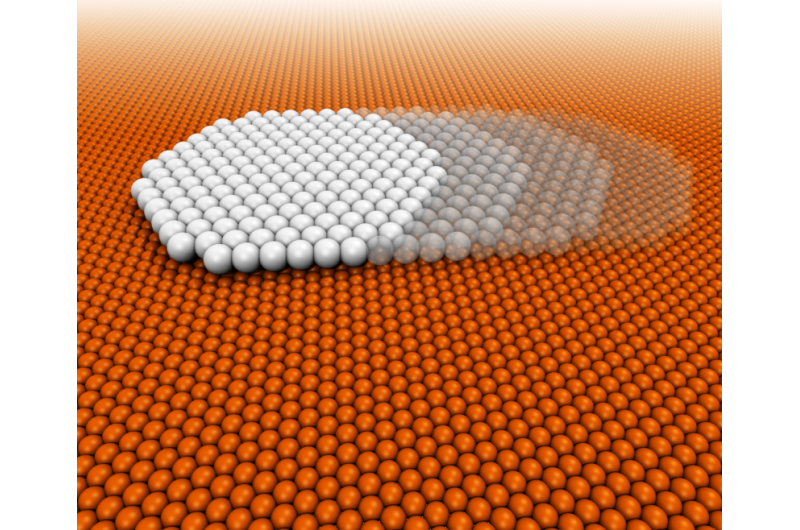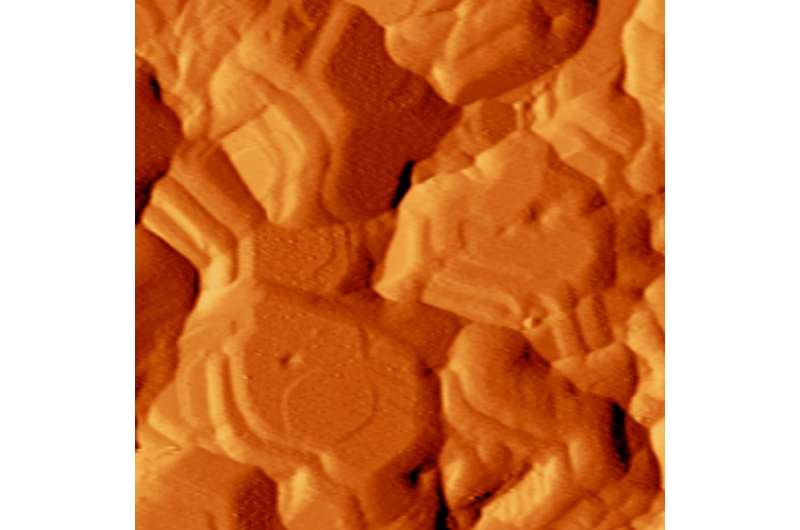Varying the sliding properties of atoms on a surface

It's possible to vary (even dramatically) the sliding properties of atoms on a surface by changing the size and "compression" of their aggregates: an experimental and theoretical study conducted with the collaboration of SISSA, the Istituto Officina dei Materiali of the CNR (Iom-Cnr-Democritos), ICTP in Trieste, the University of Padua, the University of Modena e Reggio Emilia, and the Istituto Nanoscienze of the CNR (Nano-Cnr) in Modena, has just been published in Nature Nanotechnology.
(Nano)islands that slide freely on a sea of copper, but when they become too large (and too dense) they end up getting stuck: that nicely sums up the system investigated in a study just published in Nature Nanotechnology. "We can suddenly switch from a state of superlubricity to one of extremely high friction by varying some parameters of the system being investigated. In this study, we used atoms of the noble gas xenon bound to one another to form two-dimensional islands, deposited on a copper surface (Cu 111). At low temperatures these aggregates slide with virtually no friction," explains Giampaolo Mistura of the University of Padua. "We increased the size of the islands by adding xenon atoms and until the whole available surface was covered the friction decreased gradually. Instead, when the available space ran out and the addition of atoms caused the islands to compress, then we saw an exceptional increase in friction."
The study was divided into an experimental part (mainly carried out by the University of Padua and Nano-Cnr/University of Modena and Reggio Emilia) and a theoretical part (based on computer models and simulations) conducted by SISSA/Iom-Cnr-Democritos/ICTP. "To understand what happens when the islands are compressed, we need to appreciate the concept of 'interface commensurability'," explains Roberto Guerra, researcher at the International School for Advanced Studies (SISSA) in Trieste and among the authors of the study. "We can think of the system we studied as one made up of Lego bricks. The copper substrate is like a horizontal assembly of bricks and the xenon islands like single loose bricks," comments Guido Paolicelli of the CNR Nanoscience Institute. "If the substrate and the islands consist of different bricks (in terms of width and distance between the studs), the islands will never get stuck on the substrate. This situation reproduces our system at temperatures slightly above absolute zero where we observe a state of superlubricity with virtually no friction. However, the increase in surface of the islands and the resulting compression of the material causes the islands to become commensurate to the substrate – like Lego bricks having the same pitch – and when that happens they suddenly get stuck."

The study is the first to demonstrate that it is possible to dramatically vary the sliding properties of nano-objects. "We can imagine a number of applications for this," concludes Guerra. "For example, nanobearings could be developed that, under certain conditions, are capable of blocking their motion, in a completely reversible manner."
More information: "Frictional transition from superlubric islands to pinned monolayers." Nature Nanotechnology (2015) DOI: 10.1038/nnano.2015.106
Journal information: Nature Nanotechnology
Provided by Sissa Medialab


















